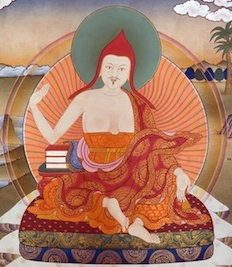Candrakīrti
Candrakīrti [alt. Chandrakirti] (T.. zla ba grags pa ཟླ་བ་གྲགས་པ་; C. Yuèchēng 月稱) (c. 600 – c. 650) was an Indian scholar who wrote commentaries on the works of Nagarjuna and his main disciple, Aryadeva. His most influential works are Clear Words (Prasannapadā) and Introduction to the Middle Way (Madhyamakāvatāra).[1] His works came to be associated with the Madhyamaka school.
Very little is known about Candrakīrti's life.[1] Tibetan sources state that he was born in South India and was a student of Kamalabuddhi. He is traditionally associated with Nalanda Mahavihara where he may have been a monk.[1]
Candrakīrti does not seem to have been influential in India during the 7th to 10 centuries,[1][2] and his works were not translated into Chinese until the 1940s.[1] However, by the 11th and 12th centuries, his work became influential in Kashmir and in Tibet. Over time, Chandrakirti became a major source for the study of Madhyamaka philosophy in Tibetan Buddhism.[1]
Views on emptiness
Candrakīrti's presentation of emptiness (sunyata) is highly influential within Tibetan Buddhism. Contemporary scholar Kevin Vose states:
- Of foremost importance in Tibetan presentations of emptiness is the seventh-century Indian Candrakirti, whose writings form the basis for studying the Middle Way in many Tibetan monasteries. Candrakirti is celebrated as offering the most thorough and accurate vision of Nagarjuna's emptiness, which, in turn, most fully represents the final truth of the Buddha's teaching. Candrakirti's idea of emptiness denies any existence to "nature" (svabhāva, rang bzhin), rejecting any enduring essence in ourselves or anywhere in the phenomenal world. In this view, our false belief in natures is at the root of our ignorance and the basis for all manner of emotional turbulence. For many Tibetan scholars, only Candrakirti's Middle Way entirely overcomes our false belief in natures and, consequently, alone overcomes ignorance and proffers freedom from cyclic existence.[3]
Chandrakirti, Bhāviveka, and the Svatantrika-Prasaṅgika distinction
In the Tibetan scholastic tradition, Candrakīrti's views on emptiness are often contrasted with those of the Indian scholar Bhāviveka. The two "schools of thought" that developed around their respective views are referred to as prasangika and svatantrika, respectively.
Kevin Vose states:
- Candrakirti frequently appears in Tibetan presentations of the Middle Way alongside Bhavaviveka (c. 500-570), whose own version of emptiness followed Nagarjuna's insights on the whole but, some maintain, failed to overcome all traces of belief in natures. Bhavaviveka, according to some interpretations, held that no nature could be found anywhere, ultimately, but that conventionally the notion of natures proved quite useful in explaining the everyday world. Candrakirti argued in his Clear Words (Prasannapada) against Bhavaviveka, despite their many commonalities as followers of Nagarjuna. Candrakirti's argument served as proof for many in Tibet that Candrakirti's emptiness was the final explanation of reality, uniquely complete, and singularly capable of yielding liberation.
- Candrakirti's critique of Bhavaviveka also formed the locus classicus for dividing the Middle Way into two camps, based on allegiance to or thematic similarity with the views of Candrakirti and Bhavaviveka. From an early period of the transmission of Buddhism, Tibetan scholars developed the genre of doxography (grub mtha; siddhanta) that, similar to Latinate compilations of Greek philosophers, organized important figures into perceived systems of thought. While Indian Buddhist authors composed similar texts, Tibetan doxographies uniquely divided the Middle Way into subschools centered round Candrakirti and Bhavaviveka. In Tibetan estimations, Candrakirti's subschool, Prasangika, consistently ranks ahead of Bhavaviveka's Svatantrika subschool at the pinnacle of all Buddhist viewpoints. Candrakirti's unique view of emptiness accounts, in some interpretations, for his top ranking.[3]
Major works
- Prasannapadā (Clear Words): a commentary on Nagarjuna's Mūlamadhyamakakārikā
- Madhyamakāvatāra (Entering the Middle Way)[4]
- Catuḥśatakaṭīkā (Commentary on the 400): a commentary on the 400 Verses of Aryadeva[5]
- Yuktiṣaṣṭikāvṛtti (Commentary on the Sixty Stanzas on Reasoning)
- Shūnyatāsaptativṛtti (Commentary on the Seventy Stanzas on Emptiness)
- Triśaraṇasaptati - Seventy Verses on Taking Refuge
References
- ↑ 1.0 1.1 1.2 1.3 1.4 1.5 Buswell & Lopez 2014, s.v. Candrakīrti.
- ↑ Vose 2009, pp. 3-4.
- ↑ 3.0 3.1 Vose 2009, p. 2.
- ↑ Ocean of Nectar: The True Nature of All Things, Tharpa Publications (1995) ISBN 978-0-948006-23-4
- ↑ Lang, Karen C. (2003). Four Illusions: Candrakīrti's Advice to Travelers on the Bodhisattva Path. Oxford University Press.
Sources
 Buswell, Robert E.; Lopez, Donald S. (2014), The Princeton Dictionary of Buddhism, Princeton University
Buswell, Robert E.; Lopez, Donald S. (2014), The Princeton Dictionary of Buddhism, Princeton University- Vose, Kevin A. (2009), Resurrecting Candrakirti: Disputes in the Tibetan Creation of Prasangika, Wisdom Publications
Further reading
 Candrakīrti, Tsadra Commons
Candrakīrti, Tsadra Commons- C. W. Huntington, The Emptiness of Emptiness: An Introduction to Early Indian Madhyamaka
- Joe Wilson. Chandrakirti's Sevenfold Reasoning: Meditation on the Selflessness of Persons, 1980
- Cesare Rizzi, Candrakīrti (Delhi: Motilal Banarsidass, 1988).
- David Seyfort Ruegg, The Literature of the Madhyamaka School of Philosophy in India (Wiesbaden: Harrassowitz, 1981).
- Lobsang N. Tsonawa, Indian Buddhist Pandits from The Jewel Garland of Buddhist History (Dharamsala: Library of Tibetan Works and Archives, 1985).
 Chandrakirti, Wikipedia
Chandrakirti, Wikipedia
